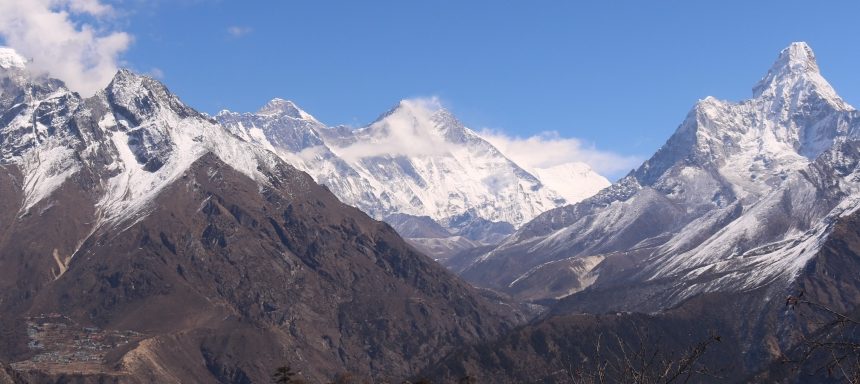When the 1953 Everest Expedition members arrived in Kathmandu in early March 1953 they had already been travelling for several weeks. The majority had sailed from Tilbury in early February to Bombay, from where they travelled north by train to the Nepalese border.
There were no roads into Nepal so from here they either walked or rode ponies through the steep Himalayan foothills to reach the fabled Kathmandu Valley, the heart of the Forbidden Kingdom of Nepal that had opened its borders to foreigners only a couple of years before.
They found themselves in a medieval city with a population of a few hundred thousand and were lodged at the British Residence. A curfew was in place every night allowing the nobility, to whom a new password was issued every day, the freedom to travel the streets unimpeded. The fifty or so cars that graced the city’s streets had been dismantled, carried by porters through the mountains and reassembled for the nobility to enjoy.
 An advance party of Charles Evans & Alfred Gregory had arrived on 20th February and set about the initial preparations of organising the required number of porters to carry the equipment and supplies to the mountain. This operation was based at Bhaktapur, a town some 10 km east of Kathmandu and in total some 350 porters were recruited. (Including 12 porters who carried the money to pay the rest of the porters with.)
An advance party of Charles Evans & Alfred Gregory had arrived on 20th February and set about the initial preparations of organising the required number of porters to carry the equipment and supplies to the mountain. This operation was based at Bhaktapur, a town some 10 km east of Kathmandu and in total some 350 porters were recruited. (Including 12 porters who carried the money to pay the rest of the porters with.)
They were split into two groups, with 150 leaving for Everest on the 10th March and 200 the following day. They arrived at Thangboche Monastery on the 26th and 27th March, a location chosen as their Preliminary Base Camp. The route they followed is shown in basic maps they created – no others existed at the time – in both the Expedition Leader John Hunt’s book “Everest Adventure” and Expedition Member Wilfred Noyce’s “South Col” (shown above).
The Explorers against Extinction Expedition 2020 had a somewhat easier journey to Nepal. 12 hours of flying, with one stopover, brought its four members straight to Kathmandu. Its objective, unlike the 1953 Expedition, was not to climb the mountain but to recreate its route as far as possible. It was also to study the high-altitude glaciers of the Khumbu Region to look for signs of their retreat due to Global Warming.
 One of the team was Mark Lewin, part of the Explorers Against Extinction Young Explorers Scheme. It was him, accompanied by charity trustee Robert Ferguson, who were to follow the Expedition route.
One of the team was Mark Lewin, part of the Explorers Against Extinction Young Explorers Scheme. It was him, accompanied by charity trustee Robert Ferguson, who were to follow the Expedition route.
The journey from Bhaktapur to Thangboche was completed by the ‘53 Expedition in 17 days. The rate of progress was restricted by the distance the porters could cover each day with their heavy loads. In 2020 the distance was covered in 9 days, including an acclimatization day.
The trip time was shortened by the fact that roads now cover much of the first week of the trek. For example, the ‘53 Expedition spent their first night in Banepa near the eastern side of the Kathmandu Valley. In 2020 we drove through this now sprawling town after only 30 minutes. We reached Dolalghat after 90 minutes, four days into their trek. In ’53 they recorded swimming at the confluence of rivers here.
We drove through Kirantechap and Yarsa (near Jiri Bazaar) and started walking four hours climb before the Chyangma Pass. From here on we followed the same trails as in 1953, although with the construction of 4×4 roads into the valleys some were now in a bad state of repair as so little used.
We crossed the Lamjura La Pass in heavy snow. In 1953 they stopped in beautiful sunshine to look at the main Himalayas to the North. Junbesi is a lovely village still centred on a large Buddhist Stupa at its heart, with a large monastery perched on the hillside above.
Several of the ’53 expedition members commented on the bridges. Those requiring longer spans were made of chains, with two lower ones supporting wooden slats to walk on and two higher ones as handrails. These have now all been replaced by steel suspension bridges leaving you much less exposed. The technology has improved and allowed for longer bridges – the longest (and highest) now is below Namche Bazaar and spans c.125 metres. Its known as the Hillary Bridge.
slats to walk on and two higher ones as handrails. These have now all been replaced by steel suspension bridges leaving you much less exposed. The technology has improved and allowed for longer bridges – the longest (and highest) now is below Namche Bazaar and spans c.125 metres. Its known as the Hillary Bridge.
Smaller rivers and streams are still crossed on more traditional wooden bridges, a design almost unchanged since 1953 (See photo above).
At Jubing we descended into the Dudh Kosi Valley – the river that flows from the glaciers around Everest and turned north, now following one of the main trading trails from Tibet to India, as used in ‘53. It was well maintained, and we met frequent mule trains, some up to 50 animals long, returning from carrying loads of supplies to the villages up the valley. A jeep road reaches just after Khari Kola before ending with three diggers gouging away at the steep hillside. They plan to take it to the small town of Lukla by 2022 before finishing it there.
From now on we followed the exact route the ’53 Expedition took to Base Camp. The next main village was Namche Bazaar, the main trading centre for Sherpas in the Upper Khumbu. It sits in a small horseshoe hanging valley, high above the confluence of the Dudh and Bhote Kosi rivers, looking south.
 Except for the Stupa and Mani Stone valley at the bottom of the settlement and the small monastery to the west, it was almost unrecognisable from the ’53 photos. Trekking is big business here, with most visitors taking a rest day here to acclimatise to the fact you have climbed over 10,000 ft for the first time. The lodges rise to 4-5 stories, dwarfing the old homes that had been single story dwellings.
Except for the Stupa and Mani Stone valley at the bottom of the settlement and the small monastery to the west, it was almost unrecognisable from the ’53 photos. Trekking is big business here, with most visitors taking a rest day here to acclimatise to the fact you have climbed over 10,000 ft for the first time. The lodges rise to 4-5 stories, dwarfing the old homes that had been single story dwellings.
Whereas before there had been only a weekly market now there are cafes, restaurants and shops. There was no trace, lost in a Army Post, of the Indian radio station that James Morris from “The Times” got his all-important dispatches about the successful climb radioed to the British Embassy in Kathmandu.
The final stage of the ‘53 walk-in to Everest took them to Thangboche, where many of the porters were paid off. This was to be their Preliminary Base Camp and from here high altitude porters were to ferry the equipment and supplies north beside the Khumbu Glacier to their advanced base camp on the Khumbu Ice flow itself – what was to become the place that future Base Camps were established by later expeditions.
Thangboche sits on a forested spur that juts out into the Dudh Kosi valley (foreground of left hand image below) and its Monastery was, and is, the largest and most sacred place in the whole region for the Sherpa people. Grass meadows to the Monastery’s north, with a stone Stupa in its centre, was used as the camp/store. These still exist albeit with several lodges now built on their northern fringe.

Part 2 of this article will cover the journey between Thangboche and Advanced Base Camp and a look at the current state of the Glaciers in this spectacular mountain region.


